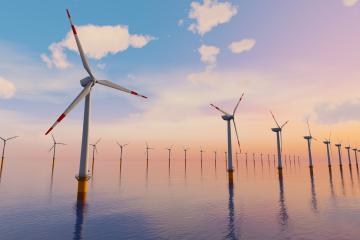Julie Lundquist, the new Bloomberg Distinguished Professor of Atmospheric Science and Wind Energy at Johns Hopkins University, is an atmospheric scientist who uses observational and computational approaches to understand the atmospheric boundary layer, with an emphasis on atmosphere-wind energy interactions. She holds appointments in the Department of Mechanical Engineering in the university's Whiting School of Engineering and in the Department of Earth and Planetary Sciences in the Krieger School of Arts and Sciences. She is also a core faculty member in the Ralph O'Connor Sustainable Energy Institute.

Image caption: Julie Lundquist
Lundquist discussed the promise and potential impacts of the Biden-Harris administration's recently approved Maryland Offshore Wind Project, which aims to expand Maryland's offshore wind energy. Ultimately, the effort will include the installation of 114 new wind turbine generators, four offshore substation platforms, a meteorological tower, and four offshore export cable corridors and could provide 2 gigawatts of renewable energy capacity to power more than 718,000 homes.
How will the newly approved projects contribute to the overall energy grid in the United States?
This effort comprises the 10th commercial-scale offshore wind energy project approved under the Biden-Harris administration. As fossil fuel plants are retired, these renewable energy projects are essential to keep our grid functioning and provide reliable electricity to our communities. Offshore wind enables access to faster and less turbulent wind than onshore wind. As these projects are situated just 10 miles off the coast, they are closer to larger population centers than many onshore wind projects, which makes it easier to integrate their renewably generated electricity into our electrical grid.
What are the expected environmental benefits of these projects in terms of real impact on carbon emissions? How about the impact on local economies?
The environmental impact can be considerable. Depending on which fossil fuel projects are retired, this wind energy effort could eliminate approximately 5 million metric tons of carbon dioxide emissions over the lifetime of the projects. Another environmental benefit is that many offshore wind farms have become artificial reefs, attracting many different marine species, which has been helpful for the fishing industry in places like the North Sea.
They also provide economic benefits. It is projected that this project will support more than 2,600 jobs annually over the seven years of its development and construction. And in some instances, offshore wind projects have led to increased tourism in the areas where they're located.
Having a steady stream of offshore wind development projects like these helps the overall offshore wind industry, too, resulting in economies of scale as installation and maintenance equipment is constructed and the workforce develops. We're at the beginning of an exciting growth period.
What technical innovations have been key to advancing offshore wind development, and are there significant regulatory or other barriers we still need to overcome?
The pace of technical innovation for offshore wind is very exciting. To take advantage of the steadier offshore wind, bigger turbines are being built to become capable of providing more power from each structure. These larger turbines interact with more complex regions of the atmosphere, making it important for us to better understand the structure and dynamics of the atmosphere over water. We currently have a lot of open questions regarding the winds and turbulence there, but we're now conducting experiments that are helping us advance our understanding and prediction capability.
Another issue we must address if we are to realize the full potential of offshore wind farms is further developing floating wind systems, which are essential for locations such as the West Coast with deeper water but are also more complex due to the interactions of wind and waves with the structures, making their control systems much more challenging. These types of technical challenges require expertise in a range of areas, including atmospheric and oceanic sciences, mechanical engineering, electrical engineering, and of course economics and policy—we need to be training students in all of these areas to become leaders in this growing industry.









